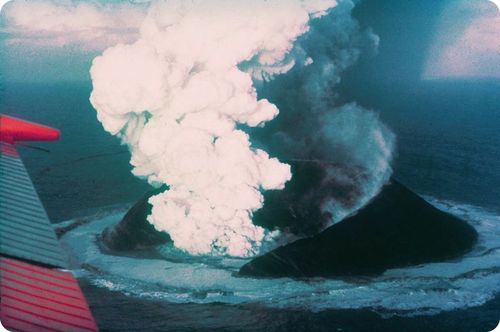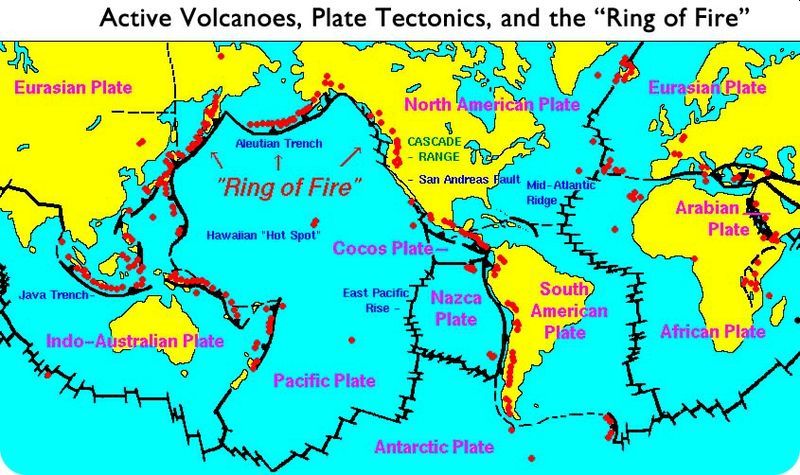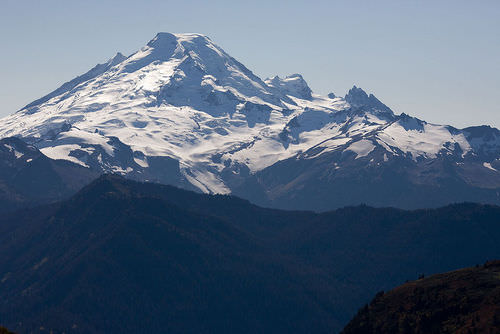48 Volcanoes at Plate Boundaries
A volcano is a vent through which molten rock and gas escape from a magma chamber.
- •Magma is molten rock underneath the earth’s surface.
- •Lava is magma on the earth’s surface.
National Geographic Volcanoes 101:
Convergent Plate Boundaries
Converging plates can be oceanic, continental, or one of each. If both are continental they will smash together and form a mountain range. If at least one is oceanic, it will subduct. A subducting plate creates volcanoes. Locations with converging in which at least one plate is oceanic at the boundary have volcanoes.
Melting
Why does melting occur at convergent plate boundaries? The subducting plate heats up as it sinks into the mantle. Also, water is mixed in with the sediments lying on top of the subducting plate. This water lowers the melting point of the mantle material, which increases melting. Melting in the mantle above the subducting plate leads to volcanoes within an island or continental arc. Volcanoes at convergent plate boundaries are found all along the Pacific Ocean basin, primarily at the edges of the Pacific, Cocos, and Nazca plates. Trenches mark subduction zones, although only the Aleutian Trench and the Java Trench appear on the map in figure 1.

Figure 1. The Cascade Range is formed by volcanoes created from subduction of oceanic crust beneath the North American continent.
Remember your plate tectonics knowledge. Large earthquakes are extremely common along convergent plate boundaries. Since the Pacific Ocean is rimmed by convergent and transform boundaries, about 80% of all earthquakes strike around the Pacific Ocean basin (the ring of fire).
Why are 75% of the world’s volcanoes found around the Pacific basin? Of course, these volcanoes are caused by the abundance of convergent plate boundaries around the Pacific.
Pacific Rim
The Pacific Ring of Fire is where the majority of the volcanic activity on the Earth occurs. A description of the Pacific Ring of Fire along western North America is a description of the plate boundaries.
- Subduction at the Middle American Trench creates volcanoes in Central America.
- The San Andreas Fault is a transform boundary.
- Subduction of the Juan de Fuca plate beneath the North American plate creates the Cascade volcanoes.
- Subduction of the Pacific plate beneath the North American plate in the north creates the Aleutian Islands volcanoes.
This incredible explosive eruption of Mount Vesuvius in Italy in A.D. 79 is an example of a composite volcano that forms as the result of a convergent plate boundary.
Volcanoes at convergent plate boundaries are found all along the Pacific Ocean basin, primarily at the edges of the Pacific, Cocos, and Nazca plates. Trenches mark subduction zones.
The Cascades are a chain of volcanoes at a convergent boundary where an oceanic plate is subducting beneath a continental plate. Specifically the volcanoes are the result of subduction of the Juan de Fuca, Gorda, and Explorer Plates beneath North America. The volcanoes are located just above where the subducting plate is at the right depth in the mantle for there to be melting (Figure 1).
The Cascades have been active for 27 million years, although the current peaks are no more than 2 million years old. The volcanoes are far enough north and are in a region where storms are common, so many are covered by glaciers.
Divergent plate boundaries
Why does melting occur at divergent plate boundaries? Hot mantle rock rises where the plates are moving apart. This releases pressure on the mantle, which lowers its melting temperature. Lava erupts through long cracks in the ground, or fissures.
Mid-Ocean Ridges
Volcanoes erupt at mid-ocean ridges, such as the Mid-Atlantic ridge, where seafloor spreading creates new seafloor in the rift valleys. Where a hotspot is located along the ridge, such as at Iceland, volcanoes grow high enough to create islands (figure 4).
 Figure 4. A volcanic eruption at Surtsey, a small island near Iceland.
Figure 4. A volcanic eruption at Surtsey, a small island near Iceland.
Underwater volcanic eruption:
“Black-smokers”: prove that life at extreme conditions can exist!
Continental Rifting
Eruptions are found at divergent plate boundaries as continents break apart. The volcanoes in Figure 5 are in the East African Rift between the African and Arabian plates. Remember from the chapter Plate Tectonics that Baja California is being broken apart from mainland Mexico as another example of continental rifting.

Figure 5. Mount Gahinga in the East African Rift valley.
Summary
- Melting is common at convergent plate boundaries.
- Convergent plate boundaries line the Pacific Ocean basin so that volcanic arcs line the region.
- Melting at divergent plate boundaries is due to pressure release.
- At mid-ocean ridges seafloor is pulled apart and new seafloor is created


